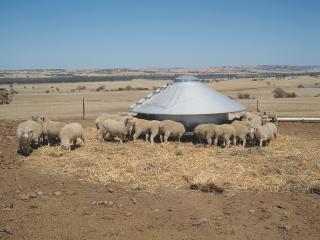Sheep producers still need to ensure their flock has access to adequate feed and water supplies despite recent widespread rainfall, according to the Department of Primary Industries and Regional Development.
Weather forecasting models continue to show a neutral chance of exceeding median rainfall for much of the agricultural region for the next two months, potentially limiting the survival of green regrowth in dry paddocks.
The department is monitoring the impact of the dry season in various parts of the State and providing relevant support to landholders via its Season 2019 webpage.
Department veterinary officer Danny Roberts said while some areas along the south coast received sufficient rainfall to cause significant germination, plant growth is reliant on regular follow-up rainfall.
Dr Roberts advised producers to continue to monitor their flock and paddocks and to revise their feed budgets, if necessary.
“It is most likely producers will have to maintain their supplementary feeding regimes for all stock, until sufficient green feed-on-offer becomes available and to tweak them where necessary,” he said.
Dr Roberts said on the positive side, any green regrowth that lasted at least a week could address any potential risk of vitamin E deficiency in weaners in the short term.
“Producers may be able to suspend drenching for vitamin E for a while but it is advisable to give a drench of 2000 milligrams per sheep in eight weeks, if green feed is not sustained,” he said.
“An alternative is to provide grain treated with vitamin E or to give stock access to green fodder, such as kikuyu, perennial shrubs or saltbush for one week every eight weeks.”
The department’s Season 2019 webpage includes articles on feed budgeting to help producers’ prioritise the supplementary feeding needs of different classes of flock.
Dr Roberts said Merino weaners were the most vulnerable section of a sheep flock and producers continue to prioritise their supplementary feed needs.
“Merino wethers need to achieve growth of 1.5 kilograms per month to ensure high survival rates at this time of the year,” he said.
“For example, a 25 kilogram weaner will require 7.4 megajoules per kilogram of dry matter, with 12 per cent protein per day to gain 50 grams per head per day.
“A weaner will eat about 2.5MJ/day of stubble or dry pasture and lose 5MJ/day, which means they will need to feed 410g/hd/day of supplementary lupin seed to achieve required growth rates.”
Dr Roberts said confinement feeding was a useful option to optimise weaners’ growth.
“It is important to ensure weaners are not hungry when they enter the confinement area,” he said.
“A 25kg weaner on supplementary feed isn’t walking a paddock to find food and water so providing the recommended 410g/head/day will suffice for slow growth.”
Access to good quality water is also crucial to ensure weaners continue to grow slowly.
“The maximum tolerance of dissolved salts, or salinity, for weaners’ drinking water is 4000 milligrams per litre for weaners, which is equivalent to 700 milliseimens per metre electrical conductivity (EC), if measuring using an EC meter,” Dr Roberts said.
“At this time of the year, dams can become muddy so it’s important to make sure access to water sources are safe.”
For more information on these and other seasonal issues, visit the department’s Season 2019 webpage, which is updated regularly with timely, relevant information on livestock management, water supply and land management options.

Media contacts:
Jodie Thomson/Megan Broad, media liaison
+61 (0)8 9368 3937
